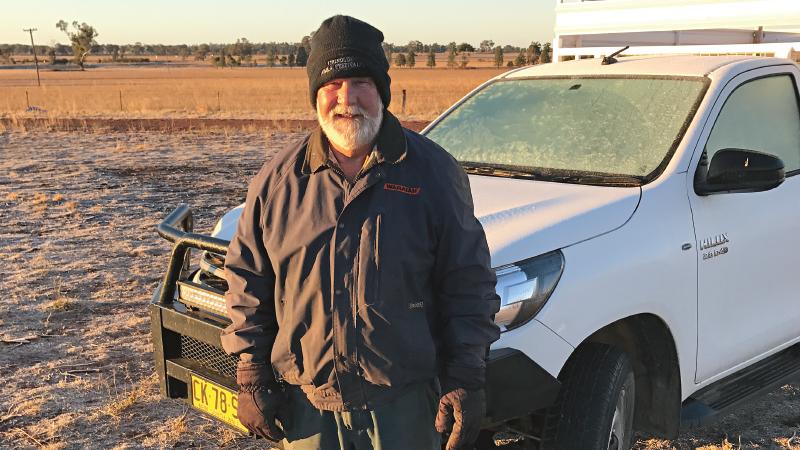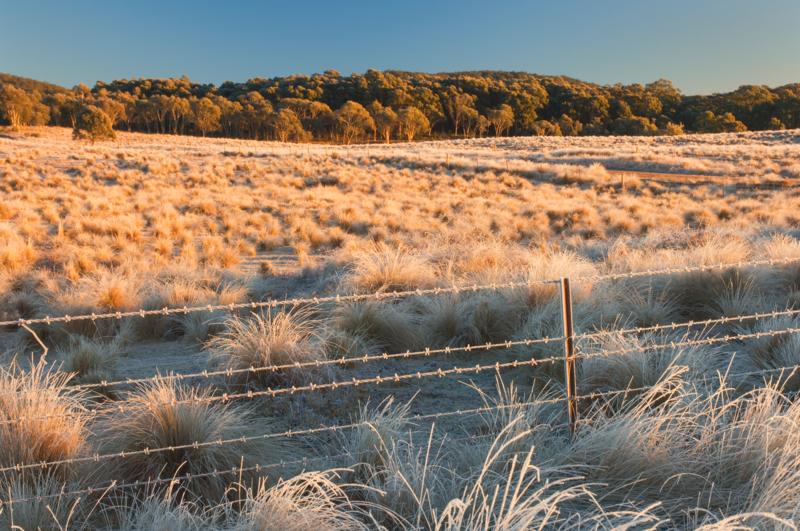WHILE most Australians love winters of clear blue skies, for farmers they can bring on a shiver of unease. As night falls and temperatures drop, they know it means a higher risk of frost, and the memory of last August’s unusually harsh snaps is still fresh in their minds.
Sheep and cropping farmer Ken Keith from Parkes in Central West NSW is among those who were hit by the severe radiation frost. Temperatures dropped to -5°C, coating his canola paddocks in white. “I think we probably had more frost than we’ve had for decades, because it was a particularly dry winter period. It wasn’t just at ground level, the frost was up in the stems,” says Ken, who is also the Mayor of Parkes Shire. He made the decision to cut his 70 hectares of hay while he could still reap the benefits of the remaining leaf matter and, with the continuing drought, his sheep have been glad of it.
In 2016, Ken suffered an even more extreme, not to mention rare, frost event – his lupin crop was devastated by black frost. “I learned about black frost at university 40 years ago, but that was the first I’d ever seen,” he says. “The frost rose a foot above ground level, froze the water in the stem cells and the lupins went black and died.” To make a bad problem worse, Ken then had a dry finish so, even with lateral tillers (later shoots), there wasn’t enough moisture to get his lupin crop home. He shakes his head. “The joys of farming...”
FEAR OF FROST VS FARMING IMPACT
It’s been said that the fear of frost is greater than the impact, and when it comes to crops, Ken agrees that can be the case, with the temptation to delay sowing to reduce frost risk. While sowing late in the season might avoid frost damage during the crucial flowering season, the shorter growing season can reduce yield. Certainly farmers who are hit by frost are also hit in the pocket.
DID YOU KNOW: frost costs the Australian grain industry an estimated $300 million-plus every year?
Following last year’s unusually high incidence of frost events, the
Grains Research & Development Corporation (GRDC) is working on a range of initiatives to manage the impact. These include developing more frost-tolerant wheat and barley varieties that could result in a yield improvement of up to 20%. But it’s not only crops that are damaged by frost. Certain species of pasture will stop growing as soon as frost hits, pulling chlorophyll out of their leaves. They stay dormant until they’re out of the frost window. Ken now plants grazing oats and brassicas to keep his sheep going over the winter, in addition to making hay and silage.
 Ken Keith in the frosty fields of his farm in Parkes.
Ken Keith in the frosty fields of his farm in Parkes.
Sheep and cattle farmer Patrick Armstrong is doing the same near Lyndhurst in the NSW Central Tablelands. Farming at elevations of up to 1,080m, Patrick sees frosts from May through to September. With a business predominantly running 1,700 Angus breeding cows, plus 1,000 sheep, he says getting animals through the winter is one of his biggest challenges.
CHANGING CLIMATE IMPACTS CROP YIELD
Sheep and cattle farmer Patrick Armstrong is doing the same near Lyndhurst in the NSW Central Tablelands. Farming at elevations of up to 1,080m, Patrick sees frosts from May through to September. With a business predominantly running 1,700 Angus breeding cows, plus 1,000 sheep, he says getting animals through the winter is one of his biggest challenges.
Patrick is originally from the Wagga-Junee area, where winters are less harsh. He has only been in Lyndhurst two years and although he had been warned about frost, it’s been a baptism of fire. Local farmers tell him last winter was one of the frostiest they’d had in a long time. He’s hoping this one isn’t so bitter and has already pushed lambing back five weeks so they land in late August instead of mid-July in the hope of reducing cold weather deaths.
“It seems everyone is changing the way they farm,” he says. “We’re constantly tweaking our management to get through winter.”
Frost is a low frequency, but high consequence, event. But as climate change becomes a constant worry for farmers, it’s easy to presume that frost events are increasing, along with every other climatic disaster. However that may not necessarily be the case. Dr Anthony Clark, climate applications and digital agriculture leader at the NSW Department of Primary Industries, says: “Analyses have been done where we’re potentially seeing increases, particularly in out-of-season October frosts, but that’s partly to do with a drying of the atmosphere in spring.
*For further insight about changing climatic conditions and the impact on farmers see our feature on Wayne and Lynette Culverson who are tackling drought conditions in Central West, NSW.
Basically, when you don’t have cloud cover, the radiation frost process is active for more of the time later in the year. “Do we have a link between more spring radiation frost and climate change? It’s definitely something we’re monitoring very carefully, but we have to be very careful in what we attribute certain events to.“Rising temperatures are very traceable. They’re driven by a big global, on average, process year on year. The reasons you get a frost are synoptic and very local, so it’s a much more difficult meteorological process to analyse in terms of trends.”
FARMING STRATEGIES TO COUNTER FROST CHALLENGES
The renegade October frost is a worry, Dr Clark says. “It can’t be tied down in terms of trends, but can be catastrophic. In 1997, it pretty well knocked out 60% of the yield in the Lower Mallee.“Over the years, farmers have developed, through a lot of hard work, really good strategies to manage the differences in seasons,” he says. But uncertainties such as frost present a real challenge. “It’s why we intensively monitor and provide information as best we can around the changes and their validity.”
The strategies introduced to counter frost challenges are myriad, from staggering flowering times for crops, to setting up greenhouses, to hiring helicopters to fly over high-value niche crops during early morning cold spells to push air around and disrupt radiation.
Central West Farming Systems research advisor Dr Neil Fettell agrees it’s hard to say that more frosts are a trend.
“It’s become more of an issue as growers are tending to sow crops earlier to avoid high temperatures and dry conditions later in the season,” he says. “It might also be an increasing problem with climate change, but that is hard to judge until there are more years of experience.”
Of course, some crops require cold temperatures. Stone fruit trees, for example, need a minimum number of hours below 7°C to break dormancy. But it’s a balancing act. Once spring growth has started, a late frost can damage the trees and their crop.
CLIMATE CONDITIONS: LEARNING TO ADAPT IN AGRICULTURE
Even without much-longed-for cloud cover to prevent freezing frosts, there are still farmers who will find silver linings. Winemaker Tim Kirk grows grapes in Murrumbateman near Yass in South East NSW, and it’s the coldness of the nights in his valley that influence the elegant style of his award-winning Clonakilla Shiraz Viognier.
A series of bad frosts meant Tim started planting vineyards higher up the slopes to avoid being hammered, but in mid-November 2006, a freak frost was so bad he lost 90% of his crop. “It got to minus two or three degrees and stayed there for a couple of hours – that was enough to do a lot of damage,” he recalls. However, he didn’t want to leave staff and facilities idle, so he bought in grapes from five surrounding vineyards and produced a new O’Riada Shiraz. It’s become such a success he continues to make 3,500 cases a year and it’s just been selected, again, for Singapore Airlines’ first class. “We probably wouldn’t have made it if it hadn’t been for that tragic 2006 frost,” he says. “We also now make a Hilltop Shiraz which is our biggest wine of all – 6,000 to 7,000 cases a year – and that also had its origins in frost. We started making it in 2000 after we were hammered by frost in 1999.
“We realised we needed another source of fruit not from this district where frost is always going to be a risk, so we added another shiraz to our portfolio from a vineyard a 90-minute drive away near Young, which is less frost-prone. That’s also very successful and served on international business class on Qantas.”
“That’s one of the things in the agricultural business – you know you’re going to have good and bad seasons. You’ve got to roll with the punches and try to snatch victory from the jaws of defeat.”
 Most nights and early mornings in Braidwood have dropped to temperatures below 0°C during the month of July.
UNDERSTANDING FROST:
Most nights and early mornings in Braidwood have dropped to temperatures below 0°C during the month of July.
UNDERSTANDING FROST:
What
Frost is a deposit of soft white ice crystals or frozen dew drops which form when the surface temperature falls below freezing point.
When
It’s most likely to form under a clear sky, with low humidity and little or no wind, especially after the passage of a cold front.
Why
The quicker the temperature drops and the longer it stays at freezing, the more likely the frost is to cause damage.
TIPS TO REDUCE THE IMPACT OF FROST:
GRAINS AND PULSES
- Identify frost-prone paddocks.
- Review nutrient management. Although there is no strong evidence that nitrogen softens wheat to frost, it can lead to a greater proportion of the canopy flowering at the same time, so manage application carefully in high-frost risk areas.
- Check out the National Variety Trial website, which provides insights into varieties of wheat and barley with the greatest risk of frost damage during flowering.
- Some crops are more susceptible to frost than others. The order of susceptibility for cereals (most to least) is durum, triticale, wheat, barley, cereal rye and oats. Field peas are the most frost-susceptible pulse crop, followed by faba beans and lupins. Canola has a good capacity to recover from frost, but is most susceptible from late flowering to the clear watery stage (about 60% seed moisture).
- Consider using multiple varieties with different flowering times and even stagger rotations in higher and lower zones.
- Reduce stubble loads, which research has shown leads to a reduction in the severity and duration of frost events.
Source: GRDC National Frost Initiative
FRUIT TREES AND HORTICULTURE
- Locate orchards out of radiation frost zones.
- Keep grass mown short, especially leading into tight cluster (early bud stage)and during fruit set.
- Spray weeds so only clean soil is present – this will trap the sun’s warmth during the day and radiate it back at night.
- Use water sprinklers. A system used widely in New Zealand, either overhead or under tree water sprinklers will mitigate frost damage.
- Open a gap in windbreak trees to improve air movement.
- Consider frost fans for small areas of high-value fruit.
- Plant rootstock with different varieties with different frost tolerance and vernalisation requirements grafted into it and re-graft if necessary.
Source: Apple and Pear Australia, NSW Department of Primary Industries